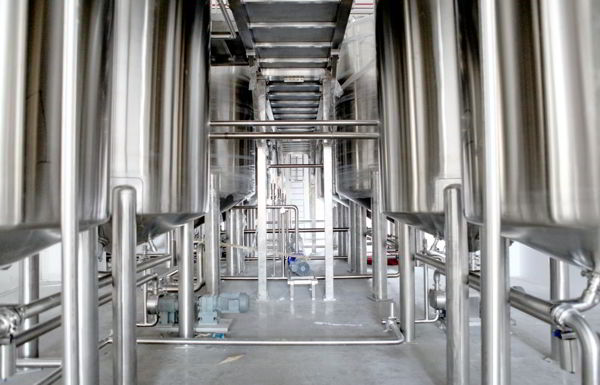In engineering, the most commonly used types of pipes are made of stainless steel. Since the Industrial Revolution, stainless steel has been used extensively in houses, industries, and offices. From pressure vessels and pipes in the oil refineries to kitchen pans, its widespread use speaks of the importance of a long-lasting and solid material that would not corrode, could be used in the extreme conditions, and would remain shiny.

In 1912, Harry Brearley invented stainless steel. He was looking for something else but ended up forming this alloy. During World War I, he was conducting experiments to discover a metal alloy that would increase the heat resistance in firearms. In the experiments, metals were corroded using various materials and then, Brearley found that when steel was treated with chrome, it became more resistant. He was not the first one who found out that steel’s strength could be enhanced by adding chrome. However, he was the first one to do it practically and sense its commercial potential.
Since then, stainless steel has come a long way and through experiments, it has a variety of types that differ based on strength, resistance, magnetic property, weldability, etc. Stainless steel has numerous properties like high heat resistance (up to 1200C), extreme corrosion resistance, weldability and formidability, rust resistance, and high durability. Apart from that, this metal does not react to many substances as well as inexpensive compared to non-corrosive, specialist alloys.
Stainless Steel Pipes Types
Stainless steel is made using basic elements like chromium, silicon, carbon, nickel, manganese, nitrogen, and iron ore. The final alloy’s properties are tailored by altering the amount of these elements. For instance, including Nitrogen in the alloy helps to enhance tensile properties like corrosion resistance and ductility.
Austenitic Stainless Steel
This is the most commonly used stainless steel type. It contains a minimum of 16% chromium making it supremely corrosion resistance. Austenitic stainless steel has an austenitic microstructure or a cubic face-centered crystal structure. Their microstructure is taken from the addition of manganese, nitrogen, and nickel. You cannot harden by heat treatment because it possesses the same microstructure at every temperature. Additionally, their microstructure provides them with excellent weldability and formability.
Austenitic stainless steel can be divided into two categories –
- 200 series – These are manganese-nickel-chromium alloys that maximize the use of nitrogen and manganese to minimize the employment of nickel. They possess 50% more yield strength than 300 series due to addition of nitrogen. If the manganese content is increased and nickel content is decreased, corrosion resistance will be reduced.
- 300 series – These are nickel-chromium alloys and they get microstructure by nickel alloying. It is the largest group and, also, the most widely used one. 321 stainless steel has amongst the best high-temperature properties, resistance to oxidation and corrosion, and good creep strength. It is used in oil refinery equipment, high-temperature chemical procedure equipment, heavy-duty and diesel auto exhaust systems, and jet aircraft components. If you want to buy stainless steel tubes or pipes for these purposes, Get Quote For 321 Stainless Steel Tube, compare the price and quality, and then make a profitable choice.
Ferritic Stainless Steel
This type of stainless steel possesses 10.5-27% chromium and zero to very little nickel content, which reduces their corrosion resistance. It is best considered for high-temperature and not for high-strength applications. It is preferred because is it stress corrosion cracking resistant. It also has magnetic qualities and the most popular grades are 434 and 430.
Precipitation-Hardening Stainless Steel
Precipitation-hardening stainless steel contains around 4% nickel and 17% chromium. The heat treatment strengthens this kind of stainless steel to level higher than martensitic stainless steel. If aluminum, copper, and niobium are added to the steel, PH stainless steel can develop extreme strength.
Martensitic Stainless Steel
It has the highest hardness and also shows magnetic properties. With a combination of heat treatment and cold work, martensitic stainless steel can be hardened. This alloy contains 12-14% chromium, 0.2-1% molybdenum, and very less amount of nickel. Also, this alloy has lower corrosion resistance as compared to ferritic and austenitic alloys but is considered strong, slightly brittle, hard, and for its ability to harden by heat treatment.
Duplex Stainless Steel
Duplex stainless steel has a microstructure that is almost 50% austenitic and 50% ferritic. They also have stress corrosion cracking resistance. Duplex stainless steel, like its name suggests, is a combination of 2 of the primary alloy types. The mixture of the alloy of 19-28% chromium, 5-7% nickel, and 0-5% molybdenum results in a mixed ferritic and austenitic microstructure.
The Bottom Line
Since stainless steel came into existence, it has been widely used. If you want to buy tubes, pipes, or other equipment made of a material that does not corrode, lose its shine, and is extremely durable, choose stainless steel ones. Based on your requirement, you can go for any of the variety mentioned above.
